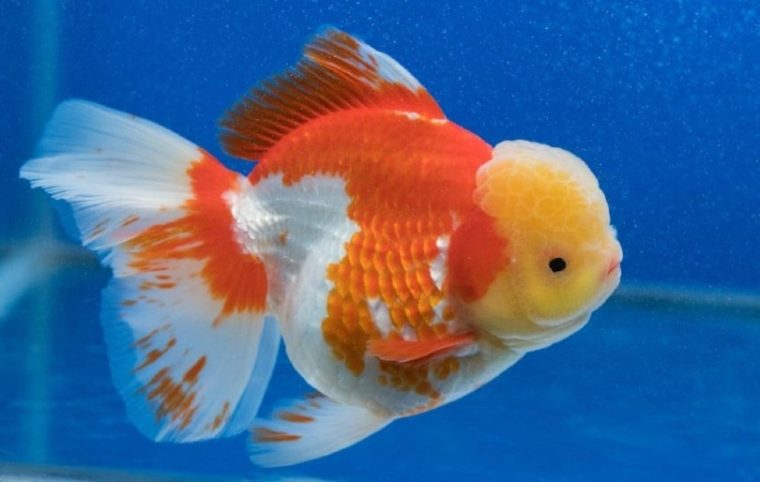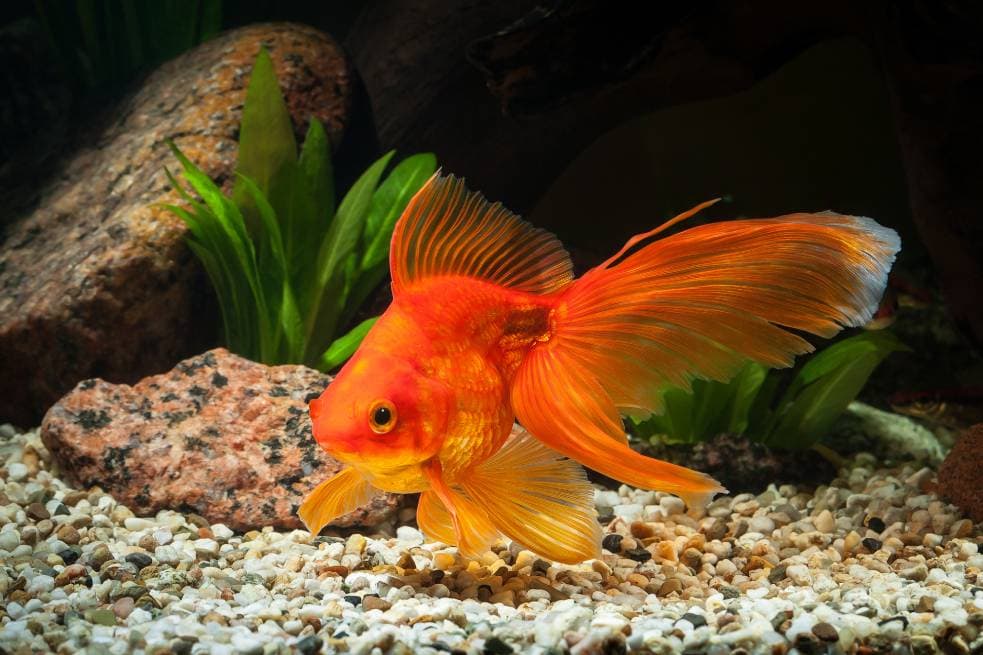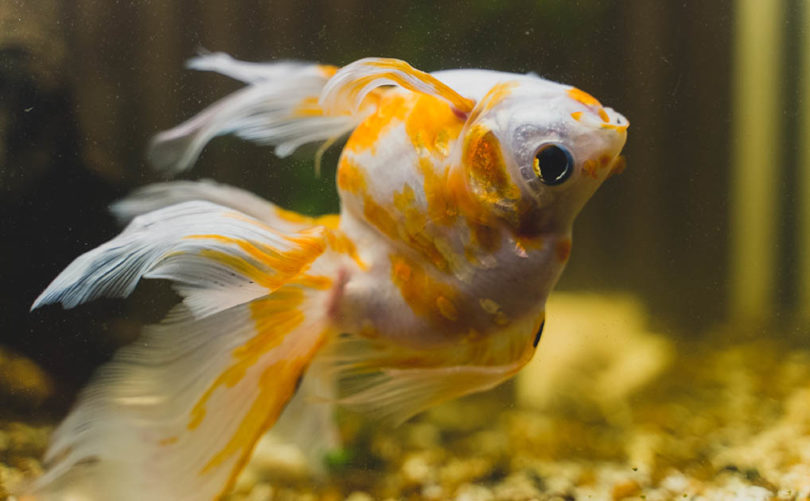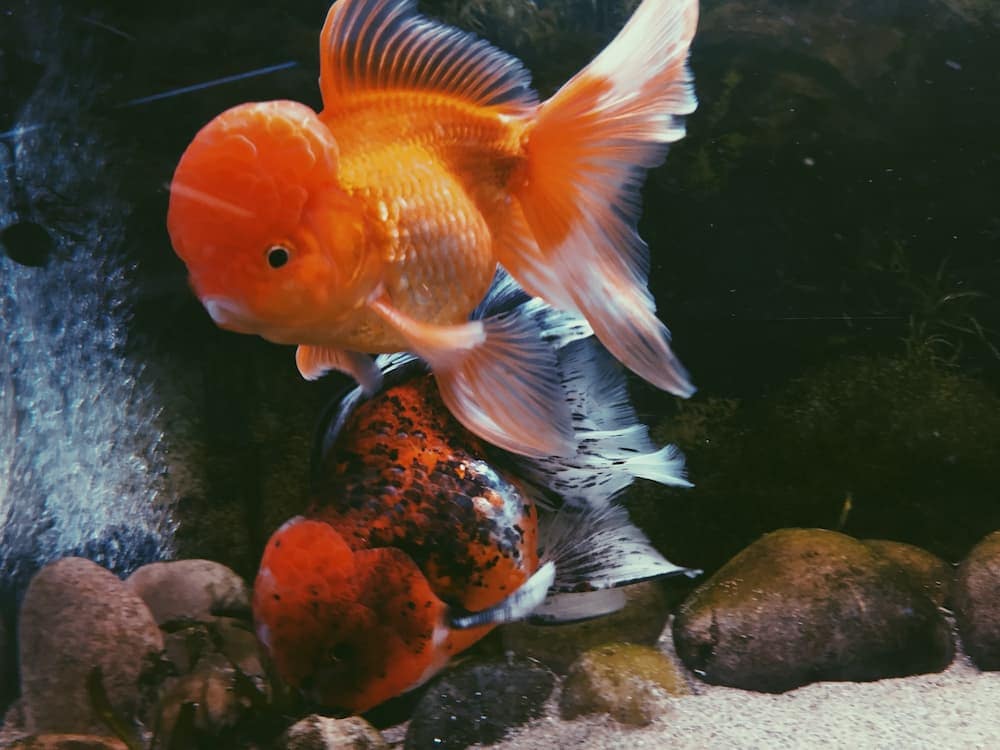
The Lionchu—also known as the Lionhead-Ranchu—originated in Thailand, where it came about as the result of crossbreeding between Lionheads and Ranchus. Amongst hobbyists, the Lionchu has become a source of fascination due to its unique appearance, gentle nature, and longevity if kept in the right conditions. In this post, we’ll explore the Lionchu in more depth and provide tips on aquarium setup and general care.
Quick Facts about Lionchu Goldfish

| Species Name: | Lionchu |
| Family: | Cyprinidae |
| Care Level: | Medium |
| Temperature: | 65°–78° F |
| Temperament: | Placid, sociable |
| Color Form: | Various, most common colors are orange, red, and white |
| Lifespan: | Up to 15 years |
| Size: | Up to 6 inches |
| Diet: | Omnivorous |
| Minimum Tank Size: | 20 gallons for one fish, 50 gallons for a community |
| Tank Set-Up: | Filtered, low water flow, softer substrates |
| Compatibility: | Tanks with small, slow-moving, non-aggressive goldfish |
Lionchu Goldfish Overview
The Lionchu first came to the world’s attention in 2006, when it was exhibited in Singapore for the first time at the My Fancy Goldfish convention. Bred in Thailand, the Lionchu quickly became popular worldwide, with hobbyists intrigued by its cute, unique appearance and generally friendly, easygoing nature.
Placid and sociable yet sensitive and delicate, this is a breed best suited to experienced aquarists as it needs a very specific kind of environment to thrive. Lionchu’s aren’t the hardiest breed, and as such, don’t do well in poor or unkempt water conditions.
An extraverted breed, the Lionchu does well in communities with equally non-aggressive, slow-moving fish. Those who keep this breed should be aware that pairing faster or more aggressive breeds with the Lionchu could result in “bullying” food-wise, as over-competition can occur.
There have been welfare concerns surrounding the Lionchu due to its lack of a dorsal fin, which limits its mobility and agility. In addition to this, the breed’s excessive facial tissue, also known as the “hood” has been marked as another potential issue. According to UFAW, this can impact vision, breathing, and movement.
How Much Do Lionchu Goldfish Cost?
This depends on the seller and color combinations, but Lionchu fish cost on average between $60 and $100 each. Lionchu with a rarer color—like black or a tricolor combination—will likely be more expensive.
Typical Behavior & Temperament
The Lionchu is known for being non-aggressive, slow-moving, placid, and friendly. As such, they thrive in aquariums with other Lionchus or fish breeds of a similar temperament. They’re far from the fastest breed, which is why they need to be kept in an environment where they won’t have to compete too much for their food.

Appearance & Varieties
A small to medium-sized fish, the Lionchu can most often grow up to 6 inches. They have a “bubbly” or “knobbly” hood that gives them a somewhat “bee-stung” or “swollen” appearance. In the mass of facial tissue, the eyes can appear slightly “sleepy” in some Lionchus.
The Lionchu also lacks a dorsal fin, as do its two parent breeds. This accounts for their being a slower-moving fish. Lionchus have fanned, twin tails, and so do both parent breeds.
The most common Lionchu color combination is orange/red and white, though more rarely, other colors can occur. This includes black, yellow, blue, calico, and tricolor combinations. Lionchus also vary in color distribution, with some being almost entirely one color with a splash of white, and others being almost completely white apart from on the head.
How to Take Care of Lionchu Goldfish
Habitat, Tank Conditions & Setup
Raising Lionchu goldfish means dedicating a certain amount of time to creating the perfect environment in which they can flourish. Again, this is a sensitive breed and as such, has specific needs. Let’s find out how best to take care of Lionchus!
Tank Size
This depends on how many Lionchus you have. If you have a single Lionchu, 20 gallons is the minimum tank size you’ll want to aim for. If you have two, it should be 30 gallons. However, if you have a whole community of Lionchus, shoot for 50 gallons minimum. Lionchus are not suited to smaller tanks.
Water Quality & Conditions
A PH level of 6.0 to 8.0 is suitable for Lionchu, which needs to be maintained. The ammonia level should always be at 0, and the nitrates level should be kept below 20. This means you’ll need to test the water for ammonia and nitrates frequently using a liquid test.
You’ll also need to change the water in your Lionchu’s tank weekly, with between 30% and 50% of the water being replaced each time. Water temperature should fall between 65°and 75° Farehnheit, and the KH (carbonate hardness) should be between 4 and 20.

Substrate
Softer, smoother substrates are best for Lionchu fish due to their sensitivity. Smooth, metal-free gravel or pebbles would be ideal—avoid rougher substrates and substrates with smaller pieces as these could be swallowed. Gravel vacuum your tank every 2 weeks or so with a vacuum that also cycles the water.
Plants
This isn’t a hard requirement, but plants are a great addition and give your Lionchus something to nibble on. As omnivorous fish, Lionchus will appreciate the variety.
Lighting
Lionchus aren’t picky in this regard—they do well in both low and high light. They’re usually more active when the lights are up and settle when the lights are darkened.
Filtration
A tank with Lionchus needs a good, powerful filtration system because these fish produce a fair amount of waste. In addition to this, their sensitivity means they will struggle in below-par water conditions.
The current should be kept low. It’s recommended to get an adjustable filter to prevent the water from flowing directly at the Lionchu’s swimming area. They’re not the best swimmers as it is, and a direct flow may further impede their ability.
Are Lionchu Goldfish Good Tank Mates?
Certainly! Lionchu goldfish are placid and easy-going tankmates. You’ll want to avoid pairing them with fast, competitive fish as they’ll beat the Lionchu out every time when it comes to reaching food first. The common goldfish is one such breed to avoid pairing Lionchu with, as are Comets and Shubunkins.
What to Feed Your Lionchu Goldfish
Lionchus are omnivores and enjoy both plant matter and meat-based foods. Commercial pellets and flakes are a good choice, as they’re often nutritionally complete. You can supplement this diet with plant matter, bloodworms, fruits, vegetables, and brine shrimp. This gives your fish some variety.
Lionchus are pretty greedy—as you can probably tell from the amount of waste they produce—so once or twice-a-day feeding should suffice.
Many goldfish die as a result of improper feeding, diet, and/or portion sizes – which can be easily prevented by proper education.
That's why we recommend the best-selling book, The Truth About Goldfish, which covers everything about goldfish nutrition, tank maintenance, illnesses & more! Check it out on Amazon today.
Keeping Your Lionchu Goldfish Healthy
Lionchu goldfish have a tendency to overeat if given the chance, so try to stick to a regime of feeding only once or twice daily. It’s also a good idea to keep an eye out to see if all of your Lionchu are getting enough food, as they’re quite slow and may lose out from time to time. Lionchus are also susceptible to bloating if fed a poor or unbalanced diet.
Apart from this, the key to keeping Lionchu fish healthy and happy is to keep their tank environment just so. That means a quality filtration system, regular water changes, appropriate substrate, and a consistent suitable temperature and PH level. This helps to avoid infections and parasites. Avoid stressing out your Lionchus by making sure they have suitable tankmates that won’t overpower them in the food department.
Avoid substrates and objects with metals, as this can pollute the water with toxins. Choose appropriate decorations for your tank, steering clear of ones with sharp edges that could scratch your Lionchus or with too-small holes to avoid them getting trapped.
Lionchus are capable of living long and happy lives, with some even reaching up to 15 years if kept in the right conditions.
Breeding
Lionchu goldfish are bred by crossbreeding between Ranchu and Lionhead goldfish. From the Ranchu, Lionchus received their curved backs, and from the Lionhead, they got their large, bubbly heads.
Are Lionchu Goldfish Suitable For Your Aquarium?
Lionchu goldfish are suitable for any aquarium with slow swimmers, excellent water quality, a quality filtration system, and appropriate size.
If you prefer hardier, lower-maintenance fish, the Lionchu isn’t the best option for your aquarium as you need to be able to maintain a certain water condition and temperature and have pretty solid and consistent cleaning routines to keep them healthy.
If, on the other hand, you’re passionate about fish, are an experienced aquarist, and are happy to take on a challenge, the sweet Lionchu will be a lovely and very special member of your tank that will bring you enjoyment for several years.
Other goldfish varieties:
Featured Image Credit: Sardo Michael, Shutterstock









